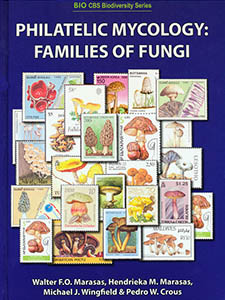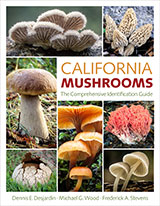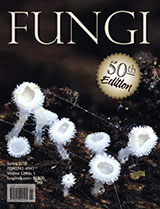Book Review
Philatelic Mycology: Families of Fungi
CBS Biodiversity Series No. 14; 2014; € 40,00
CBS-KNAW Fungal Biodiversity Centre, Utrecht, The Netherlands
ISBN: 978-90-70351-99-1 (hardcover, 107 pp.)
Although it might come as a surprise to most mycologically inclined members of the U.S. populace, mushrooms are a popular theme on postage stamps from many countries worldwide. Unfortunately, the U.S. Postal Service never has seen fit to produce even a single stamp featuring mushrooms. The best we’ve been able to do is have an occasional mushroom appear as a minor element, usually in one of the “habitat” or “ecosystem”-themed series, such as Northeast Deciduous Forest.

Over the years, I have acquired a small number of mushroom stamps but, unlike with books, have never had an urge to collect them seriously (too much work). Thus, I was pleased find that this publication from the Centraalbureau voor Schimmelcultures, an Institute of the Royal Netherlands Academy of Arts and Sciences, offers me (and you) a means to enjoy myco-philately with very little effort.
The book was the “love-child,” as the Preface describes it, of the late South African mycologist and lifelong philatelist, Wally Marasas, with his extensive collection of mushroom stamps providing its basis. Unfortunately, his premature death prevented him seeing the project through to completion and so it was taken up by the three co-authors. It includes exactly 1000 stamps (out of the perhaps as many as 5000 that have been issued), reproduced from high-resolution scans. They were issued by 109 countries and represent approximately 64 families, 150 genera, and 430 species, predominantly of macrofungi. Typically stamp collectors organize their stamps by country of origin and date of issue. This book departs from that approach by presenting the stamps following a taxonomic scheme, thus giving the user a chance to bone up on her/his systematic mycology while appreciating many lovely artistic renditions of the fungi.
The front matter consists of a brief introduction, a chart showing the phylogenetic classification used (a hybrid approach), and a list of the genera of fungi depicted on stamps. Given the rapid rate of change in our view of fungus taxonomy, the co-authors did not attempt to make the scheme up-to-the-minute, preferring instead to list some of the more important recent changes in an appendix. The back matter includes a list of references and the two-page appendix.

The stamps are numbered sequentially, 1 to 1000, and attractively presented, 30 per page (one page has only 10), on a black background. Brief summary descriptions and comments are provided for phyla, classes, orders, families, and genera. Under the genus names, each stamp is listed alphabetically by species epithet and information provided on its country of origin, date of issue, denomination, and philatelic catalog listings (Stanley Gibbons and Domfil). Some of the stamp entries also include Marasas’s brief comments about the fungus and/or its name.
The production quality generally is high, although I did find many typographical errors and the cover of my copy was bubbled. From a technical standpoint, there are numerous small errors in the taxonomic commentary, but such is to be expected when the authors were dealing with such a wide variety of fungi—one can’t be familiar with them all. However, such shortcomings should not detract from what I see as the major value of the book, which is to provide a means for mushroom enthusiasts of all levels to enjoy seeing a large number of their favorite organisms depicted on stamps without having to assemble and organize a large personal collection, stamp by stamp.


